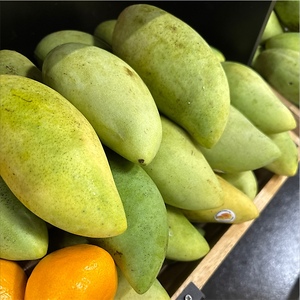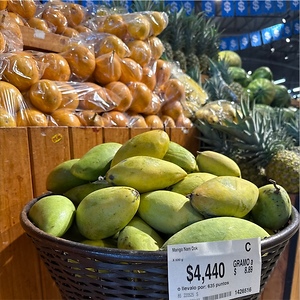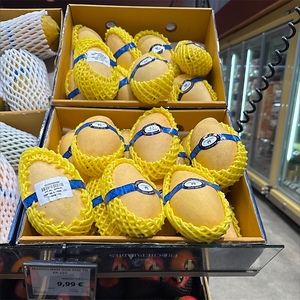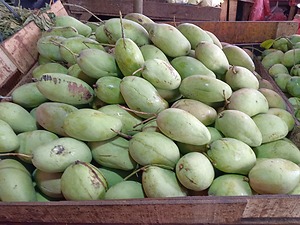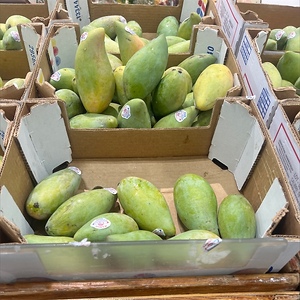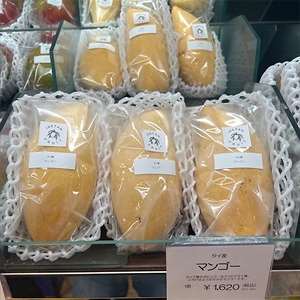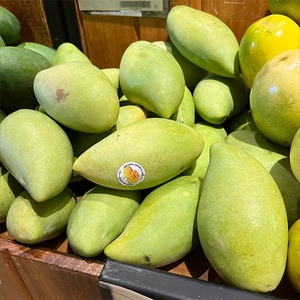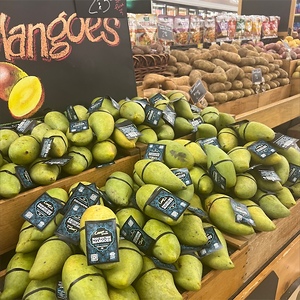

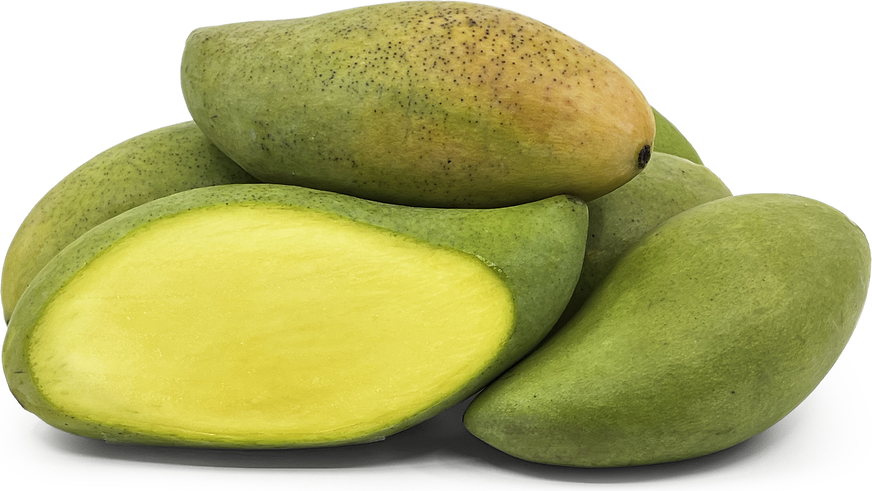
Nam Doc Mai Mangoes
Estimated Inventory, lb : 0
Description/Taste
Nam Doc Mai mangoes are a medium to large varietal, averaging 6 to 7 centimeters in diameter and 12 to 15 centimeters in length, and have an elongated, slender, and curved shape with a prominent beak or point on one end. The variety is heavy for its size, ranging from 250 to 500 grams in weight, and in Thailand, Nam Doc Mai is one of the largest varieties sold in commercial markets. The mango's skin is thin, smooth, and taut, showcasing mostly golden yellow hues when ripe, sometimes blushed with pink accents. Some ripe Nam Doc Mai mangoes may also have green still on the surface. Beyond their coloring, Nam Dok Mai mangoes exhibit small white to pale yellow lenticels and occasionally develop sugar dots on the skin when mature. Underneath the surface, the yellow flesh is fibreless, fine-grained, silky, and aqueous with a tender, succulent, soft, and melting consistency. The flesh also encases a thin and slender seed. Ripe Nam Doc Mai mangoes release a robust and intoxicating aroma. The variety is known for being one of the sweetest mangoes in Thailand, with sugar levels reaching 17 to 20 Brix, and has a honeyed, sweet, tropical, and floral flavor.
Seasons/Availability
Nam Doc Mai mangoes are available year-round in Thailand, with a peak season in March through May. In South Florida, the variety is seasonally available in June and July.
Current Facts
Nam Doc Mai mangoes, botanically classified as Mangifera indica, are an Asian variety belonging to the Anacardiaceae family. The early to mid-season cultivar is native to Thailand and is one of the most common varieties found in the country. Nam Doc Mai mangoes grow on mid-sized trees reaching over six meters in height, and the variety is a polyembryonic-seeded cultivar, meaning that the seeds will produce multiple seedlings that will be identical to their parent. Nam Doc Mai mangoes are favored for their size, taste, and consistency, and the Thai variety spread worldwide in the late 20th century, achieving international fame and recognition. Since their introduction worldwide, Nam Doc Mai mangoes have been considered a high-quality dessert cultivar and are commercially grown for fresh eating. Growers favor Nam Doc Mai mangoes for their disease resistance, productive nature, and consistent fruiting, and several variations of the original strain have been developed in breeding, notably Nam Dok Mai No. 4 and Golden Flower Water mangoes. Despite their valued characteristics, Nam Doc Mai mangoes become soft when ripe, creating shipping challenges in commercial cultivation. The variety is also notorious for dropping from the tree when almost ripe. Growers must harvest Nam Doc Mai mangoes when they are mature but still green and place the fruits in individual foam wrapping to protect the delicate surface during transport. Nam Doc Mai mangoes are a versatile variety consumed green or fully ripe in a wide array of fresh and cooked culinary preparations.
Nutritional Value
Nam Doc Mai mangoes are a source of calcium to build strong bones and teeth, fiber to regulate the digestive tract, and potassium to balance fluid levels within the bloodstream. The variety also provides vitamin A to maintain healthy organ functioning, vitamin C to strengthen the immune system, copper to develop connective tissues, and other nutrients, including folate, phosphorus, vitamin B6, iron, thiamine, riboflavin, and niacin.
Applications
Nam Doc Mai mangoes have a sweet, tropical, and floral taste suited for fresh and cooked preparations. The mangoes can be used when green or fully ripe, and the skin should always be washed prior to consumption to remove dirt, sap residue, and other particles. Green Nam Doc Mai mangoes are crunchy and sour, often used for pickles, salads, and slaws. Slices of the flesh are dipped in sauces and chili paste as a snack, and the flesh can also be added to soups and stir-fries or used in chutney and relishes. Ripe Nam Doc Mai mangoes can be halved and twisted open, discarding the seed, or the flesh can be cut off in large sections. The ripe mango flesh has a soft, succulent, and sweet taste and is primarily consumed fresh as a snack or dessert. Nam Doc Mai mangoes can also be used as an edible topping over ice cream, parfaits, and desserts, blended and frozen into ice cream, mixed into purees for sauces, or simmered into jams, jellies, and preserves. Try incorporating Nam Doc Mai mangoes into fillings for baked goods or pureeing the flesh into a batter for cakes, muffins, bread, and cookies. The variety can also complement savory recipes, including salads, curries, and a chopped garnish over meat and seafood. In Thailand, ripe mangoes are sometimes sprinkled with sugar, dried shrimp, chili powder, or salt for enhanced flavoring. Nam Doc Mai mangoes pair well with spices such as turmeric, nutmeg, cinnamon, ginger, and cloves, fruits including coconuts, bananas, pineapples, and peaches, and vegetables such as bell peppers, cauliflower, red onions, cabbage, and cucumbers. Whole, unopened Nam Doc Mai mangoes should be ripened at room temperature. Once ripe, the variety should be immediately consumed for the best quality and flavor and will keep up to seven days unopened. Sliced portions of the mango must be stored in a sealed container in the fridge, where it will keep for a few days.
Ethnic/Cultural Info
The name Nam Doc Mai roughly translates from Thai to mean "sweet water from flowers" or "sweet juice of a flower," alluding to a flower's sweet nectar. The mangoes earned this floral moniker from their honey-sweet flavor, and some mango enthusiasts also claim that ripe Nam Doc Mai mangoes release a flowery fragrance. In Thailand, Nam Doc Mai mangoes are famous as a fresh-eating variety, but they are also internationally known as being the mango of choice for Thailand's popular dessert mango sticky rice. The sweet dessert dates back to the end of the Ayutthaya Era, or sometime in the late 18th century, and Nam Doc Mai mangoes have been the variety of choice as they are in season when the dessert is traditionally served. Mango sticky rice is comprised of rice cooked in coconut milk, pandan leaves, salt, and sugar to develop a dense, sticky, and sweet dish served with freshly sliced mangoes. Since its creation, the dish has fluctuated from a cliché tourist dish to a dessert of national pride. In January 2019, Thailand's tourism industry professionals attempted the Guinness World Record for the largest serving of mango sticky rice. The world record attempt succeeded, and the sticky rice dessert was comprised of 15 tons of sticky rice along with 6,000 mangoes, including Nam Doc Mai mangoes. Mango sticky rice was also notably publicized through rapper Milli at the Coachella Music Festival in 2022. Milli was the first Thai artist to perform solo at Coachella, and in the middle of her performance, she brought out a bowl of mango sticky rice. This led mango sticky rice Google searches to skyrocket, and the dessert was sought out internationally.
Geography/History
Nam Doc Mai mangoes are native to Thailand. The variety's exact date of origin and history is unknown, but experts believe it has been grown throughout the country for several centuries. Nam Doc Mai mangoes are a favored cultivar in Thailand, and when in season, the variety is commonly sold through street vendors, roadside fruit stands, and fresh markets. In 1973, Nam Doc Mai mangoes were introduced by the United States Department of Agriculture, or USDA, from Thailand into South Florida. In Florida, the variety was widely planted in home gardens, and it was also established in the USDA Germplasm Repository in Miami, several mango farms throughout Homestead, and at the University of Florida's Tropical Research and Education Center. Nam Doc Mai mangoes are the most popular Asian variety in South Florida, but the mangoes are not cultivated commercially on a large scale as the fruits are considered too soft and delicate when ripe. In the 1980s, Nam Doc Mai mangoes were introduced from Thailand to Australia and were planted as a small commercial variety. After the success of introducing the variety to locations worldwide, the Thai government began heavily promoting Nam Doc Mai mangoes in 2009. Several trade agreements were also made to export the variety from Thailand to Korea, Japan, and China. Today Nam Doc Mai mangoes are known and cultivated as a specialty mango worldwide. The variety is grown commercially in Thailand, Colombia, and Australia, exported from Thailand into Myanmar, Vietnam, Malaysia, Singapore, China, Korea, Japan, and Europe, and is planted in home gardens in the Caribbean and South Florida.



